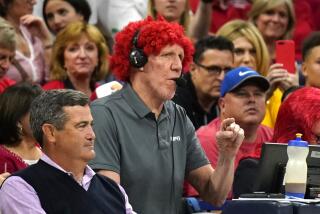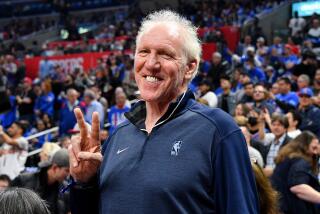It Isn’t Easy to Be a Billionaire : SAM WALTON: Made in America, My Story <i> By Sam Walton with John Huey</i> , <i> (Doubleday: $22.50; </i> 262 pp)
- Share via
Senior public figures whose deeds and decrees affect the lives of other citizens used to understand that entering the stream of history meant accepting a measure of distance from their historians. Even Ronald Reagan--who allowed Charles Mees to observe him in action during his second term--seemed to know this was true. But in the last decade best-selling “writers” like Lee Iacocca and Donald Trump discovered that they could purchase a skilled wordsmith instead of taking a chance on a writer not under their direct control.
The late Sam Walton, creator of the Ozark-based retail empire called Wal-Mart and self-made richest of all Americans, ranks among the most inspired entrepreneurs of all time. But if “Sam Walton: Made in America” is any indication, old Sam couldn’t even begin to tell you why. The co-author of Walton’s “as told to” autobiography is in this case John Huey, one of Fortune Magazine’s best reporters and writers. A reader laboring through this book need not recall the quality of Huey’s real journalism to lament the loss of the richer and more readable real book that Sam Walton’s all-American life could have made.
A prescient investor who’d purchased 100 shares of original Wal-Mart stock for $1,650 in October of 1970, would today own Wal-Mart holding worth some $3 million, but to Sam Walton, enriching his shareholders was but an ancillary purpose. Sam considers the high payouts of other CEOs “looting,” and during a time in which so many other American fortunes were being built on the provision of financial liquidity and through seeing to the transfer of corporate or land ownership, Walton eclipsed all the others by moving vast quantities of real goods out of real factories and into the possessions of millions of real customers resident near Wal-Mart stores located in the “one-horse towns” that this book shows--over and over and over again--that Sam Walton truly loved. Berryville, Arkansas; Saint Robert and Sikeston, Missouri; Claremore, Oklahoma; Dothan, Alabama; Hiawatha and Olather, Kansas . . . all of them laid out like a road map, blurring the mind and eye on almost every page.
Then there are the “partners” and “associates” at Wal-Mart who helped Sam along the way: Bob Bogie, Claude Harris, Charlie Cate, Charlie Baum, Ron and Ferold and David and Dan and Jack. Hundreds of them appear in the text without so much as a brush stroke description. Whereas many CEO “as-told-to” books read as if they had been written and expurgated in the corporate public affairs department, this one is reminiscent of those local small-town histories assembled by a committee of the historical society. I have no doubt the book will make long-time Wal-Mart employees (of which there are several hundred thousand) very happy.
Though readers do learn that Walton was a brilliant student of other retail promoters--notably of K-Mart’s Harry Cunningham and of Sol Price, Southern California’s own and the founder of Fed-Mart and the Price Clubs--those readers not of the wonderfully corny and remunerative Wal-Mart culture more often have to settle for long lists of hoary retail platitudes at the beginning (“Give your customers what they want”), and a similar list of management platitudes at the end (“Stay lean, fight bureaucracy”).
“I’ve never been a very reflective fellow,” Walton and Huey write on Walton’s behalf early in the book, and if this book is nothing else, “Sam Walton” is a shapeless and often endless testament to the truth of this statement. As he appears in his own words, Walton seems to be a man utterly lacking in personal insight. One early page he complains about the bother of becoming known as the richest man in America. Every “harebrained, cockamamy schemer in the world” apparently tries to hit Walton up for money. As an example of said scheming, Walton then recalls a letter from a woman who wrote, “I’ve never been able to afford the $100,000 house I’ve always wanted. Will you give me the money?”
Can you imagine? But then nobody ever said its easy to be a billionaire.
Walton’s lack of understanding of the purpose and nature of philanthropy is enough to make you cringe. He actually argues that saving his customers money by discounting merchandise is his way of “giving something back.” After declaring that Wal-Mart, a corporation with a market capitalization of more than $50 billion dollars, is “not in the charity business,” Sam notes that he did pay for the exercise facility for employees at the company’s Bentonsvile, Arkansas, headquarters. We learn that it was Sam’s wife, Helen Walton, not Sam, who championed the idea of profit-sharing at Wal-Mart (like so many of the couples who have occupied the White House in recent years, one senses from this book that it is the leader’s wife with whom you would want to spend an afternoon talking about life).
“I realize this may sound boring to most of you,” Walton proclaims in a rare moment of insight, “but,” he continues, more typically, “one of my best items ever was a mattress pad called a Bedmate. I think I picked this one up one day . . .”
. . . and on and on, item after item, town after town, employee after employee.
I assume it was John Huey who thought to intersperse Sam’s musings with miniature oral histories drawn from various business associates and family members. What is revealed of Sam Walton in his book usually derives from the juxtaposition of his own voice with that of others. On page 144, for instance, Sam claims that the game of golf was “a little too country club” for his tastes. But in the next paragraph, Helen Walton reveals that Sam’s lack of mastery of the game while still in the army caused him to break a club against a tree, throw the other clubs to the ground, and quit the game for good. The next paragraph has Sam noting that “for some reason” he liked to play the game he did master--tennis--under the noonday sun. The paragraph after that, a quote from one George Billingsley, a tennis partner, notes that Sam played at noon because he wouldn’t dream of taking a Wal-Mart employee away from work at any other time.
In bits and pieces, the witnesses help assemble a portrait of a good ol’ boy business wizard, a man unruined by wealth, and--perhaps above all else--a control freak extraordinaire.
Some employees get drunk at a company picnic, and Sam bans alcohol from similar events for good (“They were never quite the same after that,” observes a witness). Walton tries to retire during the 1970s, but he just can’t let go (his return inspiring the exodus of a third of his officer corps). Walton tells employees to raise their right hands and say, “From this day forward, I solemnly promise and declare that every time a customer comes within ten feet of me, I will smile, look him in the eye, and greet him. So help me Sam.”
Sam ran the show (“I’ve pretty much gotten my own way for the whole run.”) and intends to continue to do so from beyond the mortal coil. After holding forth upon the ostentatious foolishness of those who flaunt their personal wealth, he states, “One of the real reasons I’m writing this book is so my grandchildren and great-grandchildren will read it years from now and know this: If you start any of the foolishness, I’ll come back and haunt you. So don’t even think about it.”
So help them Sam.
Wouldn’t it have been wonderful to have Walton’s own perceptions and those of his colleagues, friends, and family as the basis of a real biography? Then the man and the mammoth economic institutions he wrought might have come to life. What was it like, I wondered while plodding through this tract, for a true entrepreneur like Walton to watch the company he fathered grow beyond his physical and intellectual grasp--beyond his own comprehension? In later years, Walton became a kind of totem at Wal-Mart, showing up at stores with his pick-up truck and bird dogs and feed cap, grinning and greeting and being the cartoon Sam the organization needed him to be.
But all we have here are the transcripts, not the book.
Whenever I read another book full of self-serving myths and unexplored self-observations that has been rendered readable by a professional writer, I have two recurrent thoughts. The first is thank goodness for the Securities and Exchange Commission, for without the scant material truths that agency requires of our public companies every three months, the chance to own a writer instead of talking to a fair and objective one might mean that we would learn nothing of these companies and their leaders at all. The second thought is more personal: What in the world will I do when no public figure feels enough loyalty to history or the purposes of independent journalism to take my phone call? What will we all do then?
More to Read
Sign up for our Book Club newsletter
Get the latest news, events and more from the Los Angeles Times Book Club, and help us get L.A. reading and talking.
You may occasionally receive promotional content from the Los Angeles Times.







